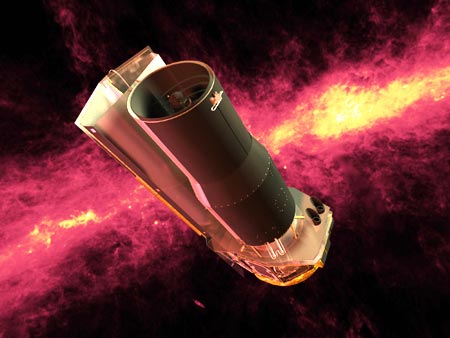Spitzer Space Telescope
Launched from Florida, USA, in August 2003, the Spitzer Space Telescope orbits the Sun rather than the Earth, trailing behind the Earth by an additional 15 million kilometers every year.

Web Site: http://www.spitzer.caltech.edu
(Image credit: NASA/JPL-Caltech.)
Lead Investigator: Dr Leigh Jenkins
NASA's Spitzer Space Telescope is the largest infrared telescope ever launched into space. The Infrared Array Camera (IRAC) on board Spitzer provides highly sensitive imaging at near-infrared wavelengths (3.6-8.0 microns), and allows astronomers to observe faint galaxies which may not be readily detected at optical wavelengths due to obscuration by interstellar dust clouds. In addition, near-infrared observations are sensitive to emission from the older stellar population rather than the younger population which can dominate the light at optical wavelengths even when they represent just a few percent of the total stellar mass. Therefore, near-infrared images provide a more direct measure of the underlying mass in a galaxy or cluster of galaxies.
In only a few hours observing time, Spitzer obtained deep, wide-field, near-infrared images of approximately 1.3 square degrees of the Coma cluster with the IRAC camera. Two fields were observed, one at the centre of the cluster, and one in an off-center region located approximately half-way between the cluster's center and edge. These images have allowed us to study the faint dwarf galaxy population of the cluster (at 3.6 microns), and to determine whether this population changes in different regions due to effects of the cluster environment. In total, we detected almost 30,000 sources over the two fields. Using optical redshift measurements, we have estimated that approximately 1600 of these are galaxies within, rather than behind, the Coma cluster. This is far more than have previously been detected at optical wavelengths. Ongoing studies with the Hectospec data will provide deeper redshift measurements, which will enable us to further refine these estimates.
A false-color mosaic of the central region of the Coma cluster, which
combines optical data from the Sloan Digital Sky Survey (color coded
blue) with long- and short-wavelength infrared views (red and green,
respectively) from the Spitzer Space Telescope. The large number of
faint galaxies detected at 3.6 microns with the IRAC camera are shown
in green.
